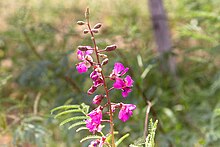| Gelrebia | |
|---|---|
 | |
| Gelrebia rubra | |
| Scientific classification | |
| Kingdom: | Plantae |
| Clade: | Tracheophytes |
| Clade: | Angiosperms |
| Clade: | Eudicots |
| Clade: | Rosids |
| Order: | Fabales |
| Family: | Fabaceae |
| Subfamily: | Caesalpinioideae |
| Tribe: | Caesalpinieae |
| Genus: | Gelrebia Gagnon & G.P.Lewis (2016) |
| Type species | |
| Gelrebia rubra (Engl.) Gagnon & G.P.Lewis | |
| Species | |
Eight; see text | |
Gelrebia is a genus of flowering plants in the family Fabaceae. It belongs to the subfamily Caesalpinioideae. It includes eight species native to sub-Saharan Africa, which range from Ethiopia to the Democratic Republic of the Congo and South Africa. [1]